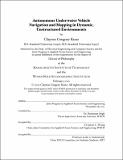| dc.contributor.advisor | Hanumant Singh. | en_US |
| dc.contributor.author | Kunz, Clayton Gregory | en_US |
| dc.contributor.other | Woods Hole Oceanographic Institution. | en_US |
| dc.date.accessioned | 2012-07-02T14:19:46Z | |
| dc.date.available | 2012-07-02T14:19:46Z | |
| dc.date.copyright | 2012 | en_US |
| dc.date.issued | 2012 | en_US |
| dc.identifier.uri | http://hdl.handle.net/1721.1/71277 | |
| dc.description | Thesis (Ph.D.)--Joint Program in Applied Ocean Science and Engineering (Massachusetts Institute of Technology, Dept. of Electrical Engineering and Computer Science; and the Woods Hole Oceanographic Institution), 2012. | en_US |
| dc.description | This electronic version was submitted by the student author. The certified thesis is available in the Institute Archives and Special Collections. | en_US |
| dc.description | Cataloged from student submitted PDF version of thesis. | en_US |
| dc.description | Includes bibliographical references (p. 91-98). | en_US |
| dc.description.abstract | This thesis presents a system for automatically building 3-D optical and bathymetric maps of underwater terrain using autonomous robots. The maps that are built improve the state of the art in resolution by an order of magnitude, while fusing bathymetric information from acoustic ranging sensors with visual texture captured by cameras. As part of the mapping process, several internal relationships between sensors are automatically calibrated, including the roll and pitch offsets of the velocity sensor, the attitude offset of the multibeam acoustic ranging sensor, and the full six-degree of freedom offset of the camera. The system uses pose graph optimization to simultaneously solve for the robot's trajectory, the map, and the camera location in the robot's frame, and takes into account the case where the terrain being mapped is drifting and rotating by estimating the orientation of the terrain at each time step in the robot's trajectory. Relative pose constraints are introduced into the pose graph based on multibeam submap matching using depth image correlation, while landmark-based constraints are used in the graph where visual features are available. The two types of constraints work in concert in a single optimization, fusing information from both types of mapping sensors and yielding a texture-mapped 3-D mesh for visualization. The optimization framework also allows for the straightforward introduction of constraints provided by the particular suite of sensors available, so that the navigation and mapping system presented works under a variety of deployment scenarios, including the potential incorporation of external localization systems such as long-baseline acoustic networks. Results of using the system to map the draft of rotating Antarctic ice floes are presented, as are results fusing optical and range data of a coral reef. | en_US |
| dc.description.statementofresponsibility | by Clayton Gregory Kunz. | en_US |
| dc.format.extent | 98 p. | en_US |
| dc.language.iso | eng | en_US |
| dc.publisher | Massachusetts Institute of Technology | en_US |
| dc.rights | M.I.T. theses are protected by
copyright. They may be viewed from this source for any purpose, but
reproduction or distribution in any format is prohibited without written
permission. See provided URL for inquiries about permission. | en_US |
| dc.rights.uri | http://dspace.mit.edu/handle/1721.1/7582 | en_US |
| dc.subject | Joint Program in Applied Ocean Science and Engineering. | en_US |
| dc.subject | Electrical Engineering and Computer Science. | en_US |
| dc.subject | Woods Hole Oceanographic Institution. | en_US |
| dc.title | Autonomous underwater vehicle navigation and mapping in dynamic, unstructured environments | en_US |
| dc.type | Thesis | en_US |
| dc.description.degree | Ph.D. | en_US |
| dc.contributor.department | Joint Program in Applied Ocean Physics and Engineering | en_US |
| dc.contributor.department | Woods Hole Oceanographic Institution | en_US |
| dc.contributor.department | Massachusetts Institute of Technology. Department of Electrical Engineering and Computer Science | |
| dc.identifier.oclc | 795567987 | en_US |
